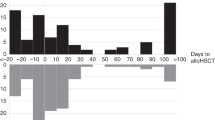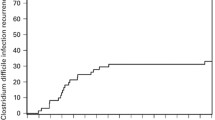Abstract
Clostridium difficile infection (CDI) is a common cause of nosocomial diarrhea and colitis. The incidence and prognostic significance of thrombocytopenia as related to mode of acquisition (hospital vs. community), NAP1/027 strain, and disease severity has not been examined. We performed a single-institution retrospective analysis of all adult inpatients from 2013 to 2014 diagnosed with CDI during their hospitalization to document the incidence/prevalence of thrombocytopenia and associated outcomes. Severe disease was defined by a composite endpoint of inpatient death, death within 30 days of discharge, presence of septic shock, or need for colectomy during hospitalization. Of the 533 patients diagnosed with CDI, moderate thrombocytopenia (platelet count <100 × 109/L at time of CDI diagnosis) was present in 15 % of the total cohort and incident thrombocytopenia developed in 3 % of patients after admission. Thrombocytopenia was more common in hospital-acquired disease and associated with increased length of stay, but was not associated with treatment failure. Those with moderate thrombocytopenia were more likely to have severe disease, after controlling for white blood cell count, albumin, and creatinine. Moderate thrombocytopenia is associated with poor prognosis and is a potential risk stratification tool for severe CDI.
Similar content being viewed by others
References
Lessa FC, Mu Y, Bamberg WM et al (2015) Burden of Clostridium difficile infection in the United States. N Engl J Med 372:825–834
Gasperino J, Garala M, Cohen HW et al (2010) Investigation of critical care unit utilization and mortality in patients infected with Clostridium difficile. J Crit Care 25:282–286
Lofgren ET, Cole SR, Weber DJ et al (2014) Hospital-acquired Clostridium difficile infections: estimating all-cause mortality and length of stay. Epidemiology 25:570–575
Leffler DA, Lamont JT (2015) Clostridium difficile infection. N Engl J Med 373:287–288
Loo VG, Bourgault AM, Poirier L et al (2011) Host and pathogen factors for Clostridium difficile infection and colonization. N Engl J Med 365:1693–1703
Khanna S, Pardi DS, Aronson SL et al (2012) The epidemiology of community-acquired Clostridium difficile infection: a population-based study. Am J Gastroenterol 107:89–95
Rao K, Micic D, Natarajan M et al (2015) Clostridium difficile ribotype 027: relationship to age, detectability of toxins A or B in stool with rapid testing, severe infection, and mortality. Clin Infect Dis 61:233–241
See I, Mu Y, Cohen J et al (2014) NAP1 strain type predicts outcomes from Clostridium difficile infection. Clin Infect Dis 58:1394–1400
Debast SB, Bauer MP, Kuijper EJ et al (2014) European Society of Clinical Microbiology and Infectious Diseases: update of the treatment guidance document for Clostridium difficile infection. Clin Microbiol Infect 20(Suppl 2):1–26
Abou Chakra CN, Pepin J, Valiquette L (2012) Prediction tools for unfavourable outcomes in Clostridium difficile infection: a systematic review. PLoS One 7:e30258
Lee DY, Chung EL, Guend H et al (2014) Predictors of mortality after emergency colectomy for Clostridium difficile colitis: an analysis of ACS-NSQIP. Ann Surg 259:148–156
Alvarado AS, Brodsky SV, Nadasdy T, Singh N (2014) Hemolytic uremic syndrome associated with Clostridium difficile infection. Clin Nephrol 81:302–306
Pant C, Madonia P, Minocha A et al (2010) Laboratory markers as predictors of mortality in patients with Clostridium difficile infection. J Investig Med 58:43–45
Abou Chakra CN, McGeer A, Labbe AC et al (2015) Factors associated with complications of Clostridium difficile infection in a multicenter prospective cohort. Clin Infect Dis 61:1781–1788
Tabak YP, Johannes RS, Sun X et al (2015) Predicting the risk for hospital-onset Clostridium difficile infection (HO-CDI) at the time of inpatient admission: HO-CDI risk score. Infect Control Hosp Epidemiol 36:695–701
Hui P, Cook DJ, Lim W et al (2011) The frequency and clinical significance of thrombocytopenia complicating critical illness: a systematic review. Chest 139:271–278
Horvath MM, Winfield S, Evans S et al (2011) The DEDUCE guided query tool: providing simplified access to clinical data for research and quality improvement. J Biomed Inform 44:266–276
Albrich WC, Rimland D (2007) Clostridium difficile: association with thrombocytosis and leukocytosis. South Med J 100:149–151
Venkata C, Kashyap R, Farmer JC, Afessa B (2013) Thrombocytopenia in adult patients with sepsis: incidence, risk factors, and its association with clinical outcome. J Intensiv Care 1:9
Poskitt TR, Poskitt PK (1985) Thrombocytopenia of sepsis. The role of circulating IgG-containing immune complexes. Arch Intern Med 145:891–894
Kuehne SA, Cartman ST, Heap JT et al (2010) The role of toxin A and toxin B in Clostridium difficile infection. Nature 467:711–713
Kurose I, Pothoulakis C, LaMont JT et al (1994) Clostridium difficile toxin A-induced microvascular dysfunction. Role of histamine. J Clin Invest 94:1919–1926
Zar FA, Bakkanagari SR, Moorthi KM Davis MB (2007) A comparison of vancomycin and metronidazole for the treatment of Clostridium difficile-associated diarrhea, stratified by disease severity. Clin Infect Dis 45:302–307
Acknowledgments
Supported by the Duke Internal Medicine Research Award.
Author information
Authors and Affiliations
Corresponding author
Ethics declarations
Conflict of interest
No conflicts of interest to report.
Rights and permissions
About this article
Cite this article
Fountain, E.M., Moses, M.C., Park, L.P. et al. Thrombocytopenia in hospitalized patients with severe clostridium difficile infection. J Thromb Thrombolysis 43, 38–42 (2017). https://doi.org/10.1007/s11239-016-1423-7
Published:
Issue Date:
DOI: https://doi.org/10.1007/s11239-016-1423-7




